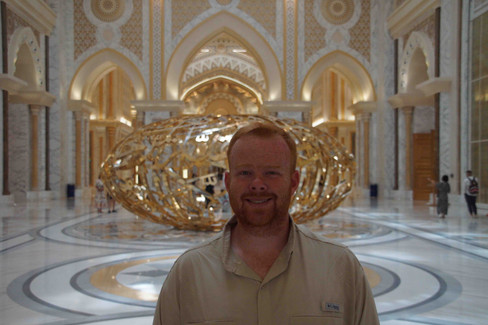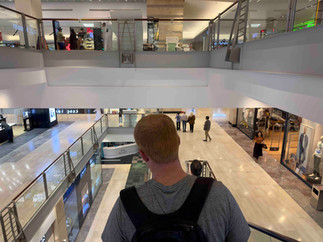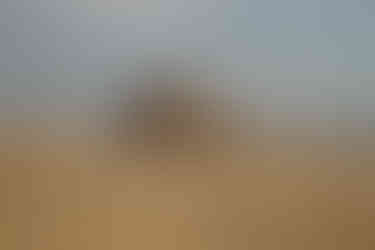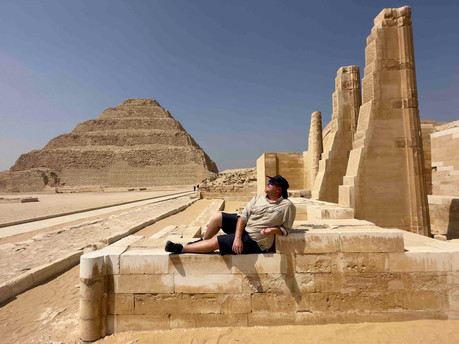Summer Adventure: Week 55, August 6-12, 2023
- Katie & Webster
- Aug 13, 2023
- 13 min read
This week has been nothing short of memorable. We started our week in Johannesburg, had a layover in Abu Dhabi, and arrived in Cairo.
On Sunday, we did a walking tour in downtown Johannesburg. Our guide, Tebogo, was a local who runs three tours a day around the city. Tebogo is a local musician, historian, and socialite who seemed to know everyone on our route. Tebogo was featured in the Toronto Star during the pandemic as he was one of the first people to trial the vaccine.
In the article, it talks about Canada and the very little we did to help developing nations get the vaccine. Tebogo was one of the only people in his community to get the vaccine because it was trialled on him. Today, vaccines are not easily accessible in South Africa.
Downtown Johannesburg is not the safest place to be, so Tebogo is the only one who runs tours showing tourists what life is like in the city centre. Most people who visit Johannesburg avoid the city centre and instead visit the neighbouring communities or townships in the near vicinity instead. We toured the city in a group of 6 people from all over the world. One of our first stops was Market Theatre where we learned about the local music scene in South Africa.
Then, we visited the Workers Museum which was a dormitory style living accommodation for workers supporting the electricity industry. All of these workers were paid an unfair wage, and given unhygienic places to live.
Our third stop was Chancellor House, across from the Johannesburg court. This used to be Nelson Mandela’s law firm, where he worked with O.R. Tambo to set up South Africa’s first black-owned law firm.
Afterwards, we took a walk though the CBD which was a busy urban hub with lots of people. This was the point on the tour where Tebogo told us to put our phones away in a zipped pocket. So although we didn’t take too many photos, we enjoyed soaking in the hustle and bustle of the city.
Our last stop was Maboneng, a new district opened in 2021 to celebrate young artists and digital creators. It was neat to see the art along the buildings and watch hundreds of people posing with the art to post on social media. We finished our tour with a traditional BBQ lunch that consisted of grilled spicy chicken, pap (local rice porridge that is sticky and smooth), coleslaw, and local vegetable medley.
In the afternoon, we went to the Apartheid Museum. Apartheid literally means a policy or system of segregation or discrimination on the grounds of race. The Apartheid were in power in South Africa until 1994 when Nelson Mandela democratically won the presidency.
The Apartheid Museum, the first of its kind, illustrates the rise and fall of apartheid. An architectural consortium, comprising several leading architectural firms, conceptualized the design of the building on a seven-hectare stand. The museum is a superb example of design, space and landscape offering the international community a unique South African experience. The exhibits have been assembled and organized by a multi-disciplinary team of curators, film-makers, historians and designers. They include provocative film footage, photographs, text panels and artefacts illustrating the events and human stories that are part of the horrific period in our history, known as apartheid. The permanent exhibition is a trip through time that traces the country’s footsteps from these dark days of bondage to a place of healing founded on the principles of a democracy. South Africa’s struggle for liberation has been a journey of pain and strife. Freedom brought peace to our land in 1994 after centuries of colonialism and more than 40 years of life under apartheid.
The museum was extremely detailed and descriptive. At some points it was disturbing and hard to handle. We spent 3 hours exploring the museum, reading personal testimony, watching videos of apartheid rulings - it was just awful to think about the life those people had to deal with.
On Monday, Webster woke up bright and early to play golf at Royal Johannesburg Golf Club.
That afternoon we did a guided tour at Constitution Hill Human Rights Precinct.
Constitution Hill is a living museum that tells the story of South Africa’s journey to democracy. The site is a former prison and military fort that bears testament to South Africa’s turbulent past and, today, is home to the country’s Constitutional Court, which endorses the rights of all citizens. There is perhaps no other site of incarceration in South Africa that imprisoned the sheer number of world-renowned men and women as those held within the walls of the Old Fort, the Women's Jail and Number Four. Nelson Mandela. Mahatma Gandhi. Joe Slovo. Albertina Sisulu. Winnie Madikizela-Mandela. Fatima Meer. They all served time here. But the precinct also confined tens of thousands of ordinary people during its 100-year history: men and women of all races, creeds, ages and political agendas; the indigenous and the immigrant; the everyman and the elite. In this way, the history of every South African lives here. Constitution Hill is also a place of contrasts: of injustice and justice, of oppression and liberation.
We did a two hour tour at Constitution Hill where we learned about the living conditions of prisoners depending on their classification. We saw Nelson Mandela’s cell where he was held, and also where Ghandi was held. Then we toured the new Constitutional Court. This is where cases are heard if they are based on racial discrimination. It is a place that has come full circle - it was once a place of imprisonment, torture, and discrimination. Today, at the same place, the court works to prevent just that. The other buildings are also used for NGO's who are working towards a country free of racial discrimination.
That night we had a low-key dinner at Rocomama's a South African owned smashburger restaurant.
On Tuesday, we did another walking tour with Tebogo in Soweto - a south-west township (So + We + To) outside of Johannesburg. Soweto was founded when the bubonic plague was killing too many people in the city. The government moved people outside of the city centre into townships to reduce the spread. When the Apartheid government gained power, townships were used to segregate the population based on the colour of their skin. Today, Soweto is famous because it is where political icons lived during Apartheid and openly led the fight against the regime.
We started our tour at the Hector Pietersen Memorial - a monument to celebrate the lives lost in the Soweto Uprising in 1976. On June 16, 1976, 20,000 school children, yes, children, marched in protest of school being taught in Afrikaans, a colonial language used by white people, that marginalized groups did not understand. At the time, Archbishop Desmond Tutu said Afrikaans was “the language of the oppressor”. Basically, the students were protesting for the right to learn in a language they could understand. During the protest police opened fire on the students killing more than hundreds of students. It is unclear how many died, as records have been tampered with, but there are estimates between 170-700 student casualties on that day. Hector Pieterson became an iconic figure representing the protest because a photo of a fellow student carrying his body was published in newspapers across the globe. This was the first photographic evidence of the Apartheid government killing citizens which resulted in sanctions from various countries around the world.
If you would like to learn more about the Soweto Uprising, the Encyclopedia Britannica has a clear history of the events on that day.
Later in the morning we visited Nelson Mandela’s home on Vilakazi Street where he lived with his first, and second wife. This is where Winnie Mandela lived when Nelson was in prison for 27 years. The home was very small - nothing more than 3 rooms with no electricity and no water. It has been preserved to showcase what his life looked like - there were even bullet holes in the bricks outside the front of the house. Today, the home is filled with honorary awards, letters from dignitaries, and photos that highlight Nelson Mandela’s life.
Afterwards, we walked to Archbishop Desmond Tutu’s house - which is on the same street, Vilakazi Street. Vilakazi Street is the only street in the world that two Nobel Peace Prize winners called home. During the 1980s Archbishop Desmond Tutu played an integral role in drawing national and international attention to the inequities under the apartheid rule. He emphasized nonviolent means of protest and encouraged the application of economic pressure from other countries. In 1984 he received a Nobel Peace Prize for his work in South Africa.
Our next stop was at the Soweto Brewery where we sampled 4 local beers made in Soweto. Many of them had unique flavours like apple pie and cherry.
Later in the afternoon, we took a local minibus taxi from Orlando West to Orlando East (approx 5km). Minibus taxis are what local residents use as public transportation. They are vans with 15 seats, each seat costs R14 or approximately $0.90CAD. Minibus taxis drive on various routes in each township. Locals learn hand signals to communicate with the drivers where they want to go (ie. thumbs down = downtown/city centre). If the driver is driving on that route, they will show the same hand signal and pull over. Minibus taxi’s that have space for people continuously honk their horns. If a minibus taxi doesn’t honk at you, they don’t have room for you in the bus. Upon entering the minibus taxi, everyone passes their cash up to the driver, passing it to the person in front of them, who passes it to the person in front of them, etc. Then, the driver hands your change back and it makes its way to you. When you want to get off a minibus taxi, you just yell. The driver will literally pull over at the side of the road wherever you want to get off, there are no stops, just a route that you can get on and get off wherever is best for you. It was definitely an experience and locals were very interested why four tourists were hopping into a minibus taxi.
Our last stop was the Orlando Towers. The Orlando Towers are built on what was originally the site of a coal-fired power station. The building of the Orlando Power Station started in 1935, and took 20 years to be completed, thanks to unforeseen delays caused by World War II. It was then shut down in 1998 and stood vacant and unused for 10 years. Today, it is an adventure park with bungee jumping, free fall diving, paint balling, underground sports arenas, and more. We wandered around the area and then enjoyed a local traditional lunch.
That evening, we enjoyed some time at the pool before heading to Grillhouse, a popular steakhouse in the same area as the hotel. We had a delicious steak to celebrate the end of our time in South Africa!
On Wednesday morning, we woke up bright and early to board a plane to Abu Dhabi. The flight was 8 hours long. When we arrived in Abu Dhabi it was 7PM and 40 degrees celsius, a big change from 5 degree mornings in South Africa. We checked into our hotel and checked out a local mall for some dinner.
On Thursday, we started our full day in Abu Dhabi with a visit to the Sheikh Zayed Grand Mosque. The Sheikh Zayed Grand Mosque is one the world’s largest mosques with 82 domes, more than 1,000 columns, 24-carat-gold gilded chandeliers and the world's largest hand-knotted carpet. The mosque complex covers more than 30 acres, excluding the parking areas - it is large enough to accommodate over 48,000 worshippers. It has four minarets, each 106 meters tall. The mosque also has seven crystal chandeliers. The largest is 10 metres across, 15 metres tall, weighs 12 tonnes, and has a staircase inside so it can be cleaned.
The late Sheikh Zayed bin Sultan Al Nahyan, the Founding Father of the UAE, built the mosque to convey historic consequence and to embody the Islamic message of peace, tolerance and diversity. He intended that the Grand Mosque be a living reference of modern Islamic architecture that links the past with the present and creates a place of Islamic science and learning that would reflect genuine Islamic values.
We spent our morning walking around the mosque complex. Then, we took a guided tour with a volunteer who is a community member at the mosque. It was neat to go behind the scenes and see some parts of the mosque that the public weren’t allowed to visit. The whole complex was a beautiful demonstration of commitment to religion.
The most interesting part of the experience was the entire underground city they have built from the parking lot to the mosque. Very similar to the PATH in Toronto, visitors enter the mosque complex from 800m away. We went down a few escalators and into a huge mall with shops, restaurants, cafes, and even a Tim Hortons! Through the mall was the entrance to the mosque via various moving sidewalks and escalators.
In the afternoon, we visited the Presidential Palace. This is not where the current Sheikh (King/President) lives but instead a workplace for government officials to conduct business, hold meetings, and welcome international dignitaries to the country.
Qasr Al Watan is a working Presidential palace in Abu Dhabi and a majestic cultural landmark that invites you to discover the rich legacy of knowledge and tradition that has shaped the UAE's journey. More than just a traditional palace, Qasr Al Watan boosts cultural understanding of the nation and emphasizes its incredible history. The palace stands as an icon of Abu Dhabi's skyline with a design exquisitely crafted to tribute to its Arabian heritage and artistry. You will feel the grandeur as you enter the grounds. The structure and open halls echo its significance in Emirati culture.
We spent the afternoon walking through the rooms, reading the displays, and soaking in the extravagance that was the entire complex.
That night, we enjoyed some time to chill (in the air conditioning) at Abu Dhabi Mall where we found American Eagle jeans for $1.82CAD!
On Friday morning we woke up bright and early to spend time at the pool before the sun got too hot. It seemed like other people had a similar idea because the pool area was busy, even at 9AM. The hotel we stayed at had a manmade beach along a bay and with a few pools. Although it was 9AM, the pool was 36 degrees and the air was already 39 degrees.
That afternoon, we checked out and headed to the airport en route to Cairo! We departed Abu Dhabi at 3PM and landing in Cairo at 6PM. When we landed we took an Uber from the airport to our hotel. The hotel dates back to 1888 when it was Mena House Hotel, a camp for archeologists. Today, it has hundreds of rooms, beautiful grounds, a huge swimming pool, and iconic views of the pyramids.
On Saturday we woke up bright and early for a day touring Cairo. We met up with our guide Mohamed, who took us on a full day tour. Mohamed is an archaeologist by trade, so he was extremely passionate about the sites. Today, he is a full time tour guide hosting guests 5-7 days each week.
Our first stop was the Giza complex - the most famous tourist stop in Cairo. Within the Giza complex there are nine temples, and the famous Sphinx.
The pyramids of Giza and the Great Sphinx are among the most popular tourist destinations in the world, and indeed already were even in Roman times. Each of these spectacular structures served as the final resting place of a king of the 4th Dynasty (c.2613–2494 BC). The Great Pyramid of Giza was built for king Khufu (c.2589–2566 BC), and the other two for Khafre and Menkaure, his son and grandson. Khufu’s pyramid is both the oldest and largest of the three, and the first building to exceed it in height would not be built for another 3,800 years! Although the three pyramids dominate the plateau, they are in fact surrounded by many other monuments. Every king’s pyramid was just one element albeit the most important of a larger complex that included smaller, subsidiary, queens’ pyramids; an additional one that acted as a second, symbolic, tomb for the king, called a satellite pyramid; mastaba tombs for nobility and other family members; burials of actual and/or symbolic boats; and a pair of temples linked by a richly decorated causeway. One of these temples, called the valley temple, led into the pyramid complex, and was located on or near a body of water where boats could dock. The other, the funerary (or upper) temple, stood near the base of the pyramid. Priests maintained the mortuary cult of the deceased king in these temples, where his divine aspect was worshiped, and where rich and diverse offerings were presented to his soul so he could have a peaceful and luxurious afterlife.
We spent a few hours wandering around the pyramids, learning about the history, and taking photos. Webster went into the Great Pyramid (the largest one) - he said it was very small, at some points he had to kneel to get through the passageways, it was very hot, and very crowded.
Then, we made our way to the Giza Plateau, a vantage point to look over the Giza complex and see all nine pyramids at once. We took a horse and carriage up to the top of the sand dune since cars are not allowed.
Our next stop was a papyrus factory where we learned about the ancient Egyptian method of making paper. It was very interesting and an educational experience for sure.
Afterwards we made a stop for lunch at a local spot for shish kebab barbecue. It was a delicious, authentic meal with lots of options!
In the afternoon, we made our way to Saqqara. Saqqara is home to the oldest pyramid - or as Mohamed phrased it, the “prototype pyramid”. This was used as a learning mechanism for the other pyramids to come, many generations later.
Located 40 km southwest of Cairo, Saqqara is one of the most important cemeteries of Memphis, which was itself one of the most important cities in ancient Egyptian history. The name of the site most likely derives from the god of this necropolis, Sokar. Saqqara is truly an open-air museum, one that has all of ancient Egyptian history on display. Kings and noblemen from the very first two dynasties (c.3040–2686 BC) were buried here, and this is also the location of the Step Pyramid of Djoser (c.2686–2667 BC). The pyramids of some of the most important kings of the Old Kingdom Fifth (c.2494–2345 BC) and Sixth (c.2345–2181 BC) Dynasties are located in Saqqara. One of these, the pyramid of Unas (also known as Wenis; (c.2375–2345 BC), features the oldest pyramid burial chamber decorated with texts. These are the so-called Pyramid Texts, the purpose of which was to protect the deceased king on his journey to the afterlife. In addition to Old Kingdom royal burials, Saqqara is also full of the tombs of the noblemen of this period, which are decorated with scenes and texts of outstanding beauty and craftsmanship.
We walked around the site, and then went into the oldest pyramid to take a look. Since it was not built to prevent thieves from entering, we walked in a beautiful entrance (where we could stand up), and where they since have added lights. It was a very cool experience. Again, since it has been open for so long, all of the antiquities that were once inside, are now gone.
Our last stop of the day was Memphis Museum - Memphis is where hundreds of pieces of an old city have been found under ordinary people’s homes. The most impressive pieces that have been found in the area are a fully intact Ramses statue, a sarcophagus, and a huge upper body of a Ramses statue.
4000 years before Cairo, Memphis bustled with palaces, temples, tombs, and embalming houses as the first capital of Egypt. A major religious center and center for the cult of the creator god Ptah was founded by king Menes during the 1st Dynasty at the beginning of the 3rd millennium B.C. Originally called Ineb-hedj and then Men-nefer, Memphis continued to be a major religious site even after the capital moved to Thebes and then to Tanis. Today, almost all of Memphis lies in ruins beneath the modern village and farmland of Mit Rahina. However, there is ongoing archaeological digging and a well-done Open Air Museum that provides a taste of the relics found so far. The highlights are the massive Ramses II statue and the alabaster sphinx of Amenophis II.
We spent some time wandering around the area looking at all of the things that had been found. Many of the items have not been moved from their original location, meaning when they were uncovered, they built the museum around the artifact, instead of moving the artifact into a museum.
That night, we enjoyed dinner overlooking the pyramids - what a view!
This week, we are spending a few more days exploring Cairo before heading to Vienna to meet up with some friends! We only have 10 more days on this grand adventure so we are making the most of every moment. Next Stop: Vienna




























































































































































































































































































































































































































































































































































































































































































Comments